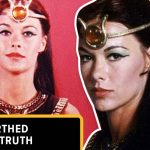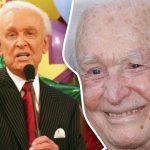By 1964, Ian Fleming’s upper-crust spy protagonist, James Bond, had officially become a successful film star. Having made the jump from page to screen with a little help from actor Sean Connery, Bond had already featured in two well-received action films, but the best just around the corner.
Producers Harry Saltzman and Albert R. ‘Cubby’ Broccoli determined to make Bond the biggest thing to hit the world stage in ages, so they got busy producing the most ambitious Bond film yet. And they accomplished just that with a splash of gold paint, one very eye-catching car, and a catchy theme song.
Goldfinger has gone down in history as being the spy film to which all other spy films look up to. You might even say that it became the ‘gold standard’. Keep watching to learn 12 astonishing facts about the making of Goldfinger.
Goldfinger Inspired By A Chance Encounter In 1956
Goldfinger the seventh installment in Ian Fleming’s series of novels about the gentlemanly spy Jame Bond, and its very premise inspired by a random encounter that he had in 1956. While Fleming was staying at an English health spa called Enton Hall, he struck up a conversation with a man whose specialty was brokering gold. As he talked to the man for a while about his line of work, the idea for Goldfinger began to take form in his mind. He published the novel three years later in 1959.
Hey, not to get too sidetracked, but if you’re enjoying this video so far, make sure you take a moment to give a like and to subscribe to Facts Verse.
And don’t even think about going anywhere just yet. Stick around to see how the special effects behind James Bond Goldfinger’s famous laser beam were accomplished.
The Book and Movie Are Very Different
As with many film adaptations of books, Goldfinger the film differs from its source material in several key ways. In both the film and the book, Auric Goldfinger wants to control the world’s gold supply, but in the novel, he’s much more of a hoarder than he is a conniving dealer. In the novel, it’s also suggested that Goldfinger would actually steal all of the gold from Fort Knox, but this a huge logistics issue for screenwriters Richard Maibaum and Paul Dehn to deal with so they watered that bit down a bit in the film. There simply was no way to show how Goldfinger could have transported all of that gold out of the repository.
So in the film, instead of stealing all of the gold, Goldfinger devised a plot to set off a dirty bomb at Fort Knox, thus irradiating the gold and making it worthless, therefore making his private stockpile all the more-so valuable.
Goldfinger Was The First Bond Film To Change-up Directors
In 1964, while the film’s producers prepared to make Goldfinger, Terence Fisher, who had previously directed Dr. No and From Russia With Love, assumed to return for the third Bond film, but he decided to step away from the project while it was still in pre-production.
Goldfinger’s producers selected Guy Hamilton to replace him. It was a historic decision that helped establish the template that every future Bond movie would follow. Stick around to see how the special effects behind James Bond Goldfinger’s famous laser beam accomplished.
Goldfinger Introduced Many James Bond Staples
When he signed on as director, Guy Hamilton recognized that he had the chance to incorporate a greater sense of lightness and fantasy into the budding Bond franchise. Worried that his lead character was ‘in danger of becoming Superman’, Hamilton chose to shift away from narratives that revolved around whether Bond would live or die to instead focus on the character conflict between 007 and his enemies.
As part of his new vision for the franchise, Hamilton introduced many Bond firsts. Goldfinger is the first Bond movie to have a cold opening in which the character goes on an unrelated mission to set the tone of the film. It was also the first film in the franchise to feature an opening theme performed by an iconic vocalist, and it was the first Bond film to build upon the relationship between 007 and his gadget-wielding cohort Q.
Sean Connery Took Some Convincing
Even though the Bond franchise had not yet reached the level of full-on frenzy that it would eventually achieve after the release of Goldfinger and Thunderball, Sean Connery was already beginning to feel overwhelmed by the weight of the franchise and what it demanded of him.
Bond turned him into a superstar, but his commitment to the series and its producer’s insistence on pumping out a film a year meant that he forced to exhaust himself working on the films while having to turn down other roles. It was a lot for one actor to put on their plate.
Connery’s apprehension was further intensified after he gave the Goldfinger script a read. He felt that it was too humorous and at times, unbelievable. He took his concerns to Hamilton who also not a fan of the original draft written by Richard Maibaum. So, screenwriter Paul Dehn brought in to revise the script, but the humor was something that remained in the film despite Connery’s concerns. Stick around to see how the special effects behind James Bond Goldfinger’s famous laser beam accomplished.
Goldfinger Introduced Bond and Q’s Dynamic
Although Desmond Llewelyn appeared in From Russia With Love, he really didn’t become fleshed out as the beloved Bond character known as Q until Goldfinger, when Bond visited his lab to receive a load of new spy gear. It proved to be a pivotal moment not just for the film, but for the entire James Bond franchise, all thanks to a crucial piece of direction from Hamilton to Llewelyn.
Initially, the actor was going to stand when Bond entered the room as a demonstration of respect, but Hamilton had something else in mind. He instructed Llewelyn to play up Q’s contempt for the cheeky secret agent man. Q wasn’t chummy with Bond, in fact, he hated the guy. Bond waltzed on into his lab every time with a puffed-up ego, disregarded what Q had to say, took his equipment, used them in entirely different ways than they intended, and never bothered to return them. So, of course, Q saw Bond as a menace – because from his perspective he was.
Goldfinger Didn’t Speak English
Even though Victor Buono and Theodore Bikel were both in the running to play Auric Goldfinger, Cubby Broccoli’s preferred choice for the role as the title character was German actor Gert Frobe who he’d seen previously play a child murderer in the film ‘It Happened in Broad Daylight’.
Hamilton agreed to the casting but flabbergasted when he found out that besides a few simple phrases, Frobe didn’t speak any English. So, instead of recasting the villain at the last minute, it decided that his lines would be dubbed over with the voice of actor Michael Collins.
Honor Blackman And Harold Sakata Were The First Choices For Their Respective Roles
Hamilton’s first choice to play Pussy Galore, Goldfinger’s seductive partner in crime, was actress Honor Blackman, who was more than ready to leave her starring role in the hit television series The Avengers and already had a working knowledge of Judo.
For the role of Oddjob, Goldfinger’s mute, brawny, hat-throwing strongman, all Hamilton had to do to find his guy was flip on his television, where he saw former Olympic weightlifter, Harold Sakata, working as a heel on a pro wrestling show.
Building The Souped-Up Car In Goldfinger Wasn’t A Walk In The Park
Goldfinger was notable for introducing a lot of Bond essentials to the franchise, but the biggest addition might have been the Aston Martin DB5. Bond’s tricked-out spymobile jam-packed full of gadgets, gizmos, and defense measures. While the film presents the vehicle as Q’s handiwork, in reality, the Aston Martin was a product of a large team of visual effects and design experts working ceaselessly to come up with its various effects.
The Aston Martin was already a compact, feature-heavy prototype, so production designer Ken Adam and special effects supervisor John Steers had to really rack their brains to come up with the means to achieve the effects seen in the finished film.
Most Of The Film’s Exotic Locales Faked
While the scenes where Bond is speeding through the Swiss Alps actually filmed in Switzerland, Goldfinger made at a time when Bond films didn’t quite have the same kind of beefy budget as they do today. Hamilton and his crew had to make extensive use of body doubles for various exotic locales. Early in the film’s production, for example, a team sent to Miami to shoot the scenes where Bond first encountered Goldfinger and Jill Masterson. Since Connery and Frober weren’t there, stand-ins used for these shots, and the hotel’s sets built at England’s Pinewood Studios. Likewise, the scenes set in Goldfinger’s various lairs, Swiss forests, and other key sets also shot in a similar manner.
It Wasn’t The Real Fort Knox
The filmmakers simply couldn’t gain access to the real Fort Knox. They couldn’t even get photographs of the facility’s interior. That presented a bit of a problem when filming Goldfinger’s epic climax.
Ken Adams and his team had to create their very own take on Fort Knox at the Pinewood studios backlot, but Broccoli rejected draftsman Peter Lamont’s original blueprints because he thought they made the place look too much like a bank.
Broccoli instead insisted that the set look like a ‘cathedral of gold’, so the team went back to the drawing board and came up with the set seen in the film – complete with stacks of gold bars protected by steel grates.
Goldfinger’s Laser Beam Scene Was A Pain For The Visual Effects Team To Pull Off
Producer Harry Saltzman came up with the idea to incorporate a laser beam into Goldfinger’s dastardly plot, and It was screenwriter Richard Maibaum’s idea to use the technology to torture James Bond himself in what has since become one of the most iconic scenes in the entire franchise. The effects team actually managed to get a hold of an actual industrial laser for the scene, but once the set was fully lit, the cameras couldn’t pick up its beam. Not wanting to nix the scene, the production team had to come up with another way of pulling off the effect.
The sheet of metal Bond was lying on was pre-cut, then solder was used to fill in the hole which was then painted over to blend in with the rest of the table. Two effects technicians then had to lay underneath the table, one holding a light and the other using a cutting torch to replicate the effect of a laser piercing through the table. The Laser beam was then optically painted into the scene.
Well, it would seem that once again we’ve arrived at the end of another facts-packed video. But hopefully, you’ve enjoyed going on this little behind-the-scenes tour of Goldfinger with us.
What was your favorite Bond movie? Are you a Goldfinger fan or perhaps you can’t get enough of The Spy Who Loved Me? Either way, let us know in the comments section below.
And before you go, take a moment to show us a little support by giving this video a like and by subscribing to Facts Verse if you haven’t already. Tap the bell to turn on notifications. That way you can be one of the lucky first to experience all of our latest and upcoming videos.


